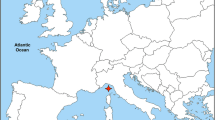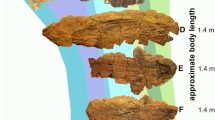Abstract
Here, we report a novel type of dermal denticle (or placoid scale), unknown among both living and fossil chondrichthyan fishes, in a Cretaceous lamniform shark. By their morphology and location, these dermal denticles, grouped into clusters in the cephalic region, appear to have been directly associated with the electrosensory ampullary system. These denticles have a relatively enlarged (∼350 μm in diameter), ornamented crown with a small (∼100 μm) asterisk- or cross-shaped central perforation connected to a multi-alveolate internal cavity. The formation of such a complex structure can be explained by the annular coalescence and fusion, around an ampullary vesicle, of several developmental units still at papillary stage (i.e. before mineralization), leading to a single denticle embedding an alveolar ampulla devoid of canal. This differs from larger typical ampullae of Lorenzini with a well-developed canal opening in a pore of the skin and may represent another adaptive response to low skin resistance. Since it has been recently demonstrated that ampullary organs arise from lateral line placodes in chondrichthyans, this highly specialized type of dermal denticle (most likely non-deciduous) may be derived from the modified placoid scales covering the superficial neuromasts (pit organs) of the mechanosensory lateral line system of many modern sharks.





Similar content being viewed by others
References
Andres KH, von Düring M (1988) Comparative anatomy of vertebrate electroreceptors. In: Hamann W, Iggo A (eds) Transduction and cellular mechanisms in sensory receptors. Progress in Brain Research 74 113–131
Baker CVH, Modrell MS, Gillis JA (2013) The evolution and development of vertebrate lateral line electroreceptors. J Exp Biol 216:2515–2522
Budker P (1938) Les cryptes sensorielles et les denticules cutanés des plagiostomes. Ann Inst Oceanogr 18:207–288
Camilieri-Asch V, Kempster RM, Collin SP, Johnstone RW, Theiss SM (2013) A comparison of the electrosensory morphology of a euryhaline and a marine stingray. Zoology 116:270–276
Cappetta H, Case GR (1975) Sélaciens nouveaux du Crétacé du Texas. Geobios 8:303–307
Cavin L, Tong H, Boudad L, Meister C, Piuz A, Tabouelle J, Aarab M, Amiot R, Buffetaut E, Dyke G, Hua S, Le Lœuff J (2010) Vertebrate assemblages from the early Late Cretaceous of southeastern Morocco: an overview. J Afr Earth Sci 57:391–412
Donoghue PC (2002) Evolution of development of the vertebrate dermal and oral skeletons: unraveling concepts, regulatory theories, and homologies. Paleobiology 28:474–507
Freitas R, Zhang G, Albert JS, Evans DH, Cohn MJ (2006) Developmental origin of shark electrosensory organs. Evol Dev 8:74–80
Gillis JA, Modrell MS, Northcutt RG, Catania KC, Luer CA, Baker CVH (2012) Electrosensory ampullary organs are derived from lateral line placodes in cartilaginous fishes. Development 139:3142–3146
Green SA, Simoes-Costa M, Bronner ME (2015) Evolution of vertebrates as viewed from the crest. Nature 520:474–482
Hueter RE, Mann DA, Maruska KP, Sisneros JA, Demski LS (2004) Sensory biology of elasmobranchs. In: Carrier JC, Musick JA, Heithaus MR (eds) Biology of sharks and their relatives. CRC Press, Boca Raton, pp 325–368
Jørgensen JM (2005) Morphology of electroreceptive sensory organs. In: Bullock TH, Hopkins CD, Popper AN, Fay RR (eds) Electroreception. Springer Handbook of Auditory Research, vol 21. New York, pp 47–67
Kajiura SM (2001) Head morphology and electrosensory pore distribution of carcharhinid and sphyrnid sharks. Environ Biol Fish 61:125–133
Kajiura SM, Cornett AD, Yopak KE (2010) Sensory adaptations to the environments: electroreceptors as a case study. In: Carrier JC, Musick JA, Heithaus MR (eds) Sharks and their relatives II—biodiversity, adaptive physiology, and conservation. CRC Press, Boca Raton, pp 393–433
Kitamura N (2013) “Carcharias” amonensis (Chondrichthyes, Odontaspididae) from the Upper Cretaceous Mifune group in Kumamoto, Japan. Paleontol Res 17:230–235
Lee RTH, Thiery JP, Carney TJ (2013) Dermal fin rays and scales derive from mesoderm, not neural crest. Curr Biol 23:R336–R337
Martill DM, Ibrahim N, Brito PM, Baider L, Zhouri S, Loveridge R, Naish D, Hing R (2011) A new Plattenkalk Konservat Lagerstätte in the Upper Cretaceous of Gara Sbaa, south-eastern Morocco. Cretac Res 32:433–446
McKenzie RW, Motta PJ, Rohr JR (2014) Comparative squamation of the lateral line canal pores in sharks. J Fish Biol 84:1300–1311
Meyer W, Seegers U (2012) Basics of skin structure and function in elasmobranchs: a review. J Fish Biol 80:1940–1967
Mongera A, Nüsslein-Volhard C (2013) Scales of fish arise from mesoderm. Curr Biol 23:R338–R339
Néraudeau D, Allain R, Perrichot V, Videt B, Lapparent de Broin F de, Guillocheau F, Philippe M, Rage J-C, Vullo R (2003) Découverte d’un dépôt paralique à bois fossiles, ambre insectifère et restes d’Iguanodontidae (Dinosauria, Ornithopoda) dans le Cénomanien inférieur de Fouras (Charente-Maritime, Sud-Ouest de la France). C R Palevol 2:221–230
Ørvig T (1972) The latero-sensory component of the dermal skeleton in lower vertebrates and its phyletic significance. Zool Scr 1:139–155
Peach MB, Marshall NJ (2009) The comparative morphology of pit organs in elasmobranchs. J Morphol 270:688–701
Peach MB, Rouse GW (2004) Phylogenetic trends in the abundance and distribution of pit organs of elasmobranchs. Acta Zool 85:233–244
Petit G, Budker P (1935) Sur la différenciation de dents cutanées, liée à la présence de cryptes sensorielles, chez quelques sélaciens. C R Hebd Séances Acad Sci 201:737–740
Pradel A, Tafforeau P, Maisey JG, Janvier P (2011) A new Paleozoic Symmoriiformes (Chondrichthyes) from the Late Carboniferous of Kansas (USA) and cladistic analysis of early chondrichthyans. PLoS ONE 6:e24938
Raschi W (1986) A morphological analysis of the ampullae of Lorenzini in selected skates (Pisces, Rajoidei). J Morphol 189:225–247
Raschi W, Mackanos LA (1989) The structure of the ampullae of Lorenzini in Dasyatis garouaensis and its implications on the evolution of the freshwater electroreceptive systems. J Exp Zool 252(Suppl 2):101–111
Raschi W, Keithan ED, Rhee WCH (1997) Anatomy of the ampullary electroreceptor in the freshwater stingray, Himantura signifer. Copeia 1997:101–107
Reif W-E (1978) Type of morphogenesis of the dermal skeleton in fossil sharks. Paläeontol Z 52:110–128
Reif W-E (1985) Squamation and ecology of sharks. Cour Forsch Inst Senckenberg 78:1–255
Reif W-E, Richter M (2001) Revisiting the lepidomorial and the odontode regulation theories of dermo-skeletal morphogenesis. N Jb Geol Paläont (Abh) 219:285–304
Sallan LC, Coates MI (2014) The long-rostrumed elasmobranch Bandringa Zangerl, 1969, and taphonomy within a Carboniferous shark nursery. J Vertebr Paleontol 34:22–33
Shimada A, Kawanishi T, Kaneko T, Yoshihara H, Yano T, Inohaya K, Kinoshita M, Kamei Y, Tamura K, Takeda H (2013) Trunk exoskeleton in teleosts is mesodermal in origin. Nat Commun 4:1639
Szabo T, Kalmijn AJ, Enger PS, Bullock TH (1972) Microampullary organs and a submandibular sense organ in the fresh water ray, Potamotrygon. J Comp Physiol 79:15–27
Theiss SM, Collin SP, Hart NS (2011) Morphology and distribution of the ampullary electroreceptors in wobbegong sharks: implications for feeding behaviour. Mar Biol 158:723–735
Tricas TC (2001) The neuroecology of the elasmobranch electrosensory world: why peripheral morphology shapes behavior. Environ Biol Fish 60:77–92
Vullo R, Guinot G, Barbe G (2014) A case of parallelism between a mid-Cretaceous lamniform and modern carcharhiniform sharks. J Vertebr Paleontol Program Abstr 2014:250–251
Wada H, Iwasaki M, Kawakami K (2014) Development of the lateral line canal system through a bone remodeling process in zebrafish. Dev Biol 392:1–14
Webb JF (2014) Morphological diversity, development, and evolution of the mechanosensory lateral line system. In: Coombs S, Bleckmann H, Fay RR, Popper AN (eds) The lateral line system. Springer Handbook of Auditory Research, vol 48. New York, pp 17–72
Whitehead DL (2002) Ampullary organs and electroreception in freshwater Carcharhinus leucas. J Physiol Paris 96:391–395
Whitehead DL, Gauthier ARG, Mu EWH, Bennett MB, Tibbetts IR (2015) Morphology of the ampullae of Lorenzini in juvenile freshwater Carcharhinus leucas. J Morphol 276:481–493
Wonsettler AL, Webb JF (1997) Morphology and development of the multiple lateral line canals on the trunk in two species of Hexagrammos (Scorpaeniformes, Hexagrammidae). J Morphol 233:195–214
Wueringer BE (2012) Electroreception in elasmobranchs: sawfish as a case study. Brain Behav Evol 80:97–107
Yano K, Goto M, Yabumoto Y (1997) Dermal and mucous denticles of a female megamouth shark, Megachasma pelagios, from Hakata Bay, Japan. In: Yano K, Morrissey JF, Yabumoto Y, Nakaya K (eds) Biology of the megamouth shark. Tokai University Press, Tokyo, pp 77–91
Acknowledgments
We are extremely grateful to G. Barbe for donating the specimen to the UM collections. We thank A.-M. Damiano for the documentation, P. Janvier for the discussion, V. Perrichot for the technical assistance and A. Piuz for the SEM imaging. We also thank the three anonymous reviewers for their constructive comments. G.G. was funded by the Swiss National Science Foundation (200021-140827).
Author information
Authors and Affiliations
Corresponding author
Additional information
Communicated by: Sven Thatje
Rights and permissions
About this article
Cite this article
Vullo, R., Guinot, G. Denticle-embedded ampullary organs in a Cretaceous shark provide unique insight into the evolution of elasmobranch electroreceptors. Sci Nat 102, 65 (2015). https://doi.org/10.1007/s00114-015-1315-2
Received:
Revised:
Accepted:
Published:
DOI: https://doi.org/10.1007/s00114-015-1315-2




